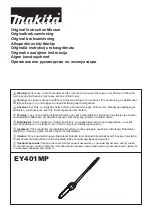
13 ENGLISH
6.
NEVER permit anyone else to stand in line with
the path of the saw blade.
7.
Before using the tool on an actual workpiece,
let it run for a while. Watch for vibration or
wobbling that could indicate poor installation
or a poorly balanced blade.
8.
The tool should not be used for slotting, rab-
betting or grooving.
9.
Replace the table insert when worn.
10.
Always store the push-stick when it is not in
use.
11.
Knock out any loose knots from workpiece
BEFORE beginning to cut.
12.
Some dust created from operation contains
chemicals known to cause cancer, birth
defects or other reproductive harm Some
examples of these chemicals are:
—
lead from lead-based-painted material
and,
—
arsenic and chromium from chemical-
ly-treated lumber.
Your risk from these exposures varies,
depending on how often you do this type
of work. To reduce your exposure to these
chemicals: work in a well ventilated area and
work with approved safety equipment, such as
those dust masks that are specially designed
to filter out microscopic particles.
13.
Always make sure that sub guard is down and
flat against saw-table before plugging in the
tool.
14.
Inspect extension cords periodically and
replace if damaged.
15.
(For European countries only)
Use only saw blades recommended by the
manufacturer and which conform to EN847-1.
INSTALLATION
Positioning table saw
►
Fig.1:
1.
Hole diameter 8 mm
►
Fig.2:
1.
6 mm Std. washer
2.
No.10 wood screw 40
mm min. length
►
Fig.3:
1.
6 mm Std. washer
2.
6 mm Mounting bolt
& Nut tighten securely
Locate the table saw in a well lit and level area where
you can maintain good footing and balance. It should
be installed in an area that leaves enough room to
easily handle the size of your workpieces. The table
saw should be secured with four screws or bolts to the
work bench or table saw stand using the holes provided
in the bottom of the table saw. When securing the table
saw on the work bench, make sure that there is an
opening in the top of the work bench the same size as
the opening in the bottom of the table saw so the saw-
dust can drop through.
If during operation there is any tendency for the table
saw to tip over, slide or move, the work bench or table
saw stand should be secured to the floor.
Storing accessories
►
Fig.4:
1.
Triangular rule
2.
Wrench
3.
Push stick
4.
Hex wrench
5.
Saw blade
6.
Lid
The push stick, triangular rule, saw blade and wrenches
can be stored on the left side of the base.
The saw blade can be stored inside the lid.
►
Fig.5:
1.
Anti-kickback pawls
2.
Holder
Place the anti-kickback pawls on the holder on the back
of the base as illustrated. Turn the clamp to secure.
►
Fig.6:
1.
Rip fence (Guide rule)
2.
Miter gauge
The rip fence and miter gauge can be stored at the right
side of the base.
FUNCTIONAL DESCRIPTION
CAUTION:
Always be sure that the tool is
switched off and unplugged before adjusting or
checking function on the tool.
Blade guard
WARNING:
Never defeat or remove the blade
guard.
An exposed blade as a result of defeated guard-
ing may result in serious personal injury during operation.
WARNING:
Never use the tool if the blade
guard is damaged, faulty or removed.
Operation of
the tool with a damaged, faulty or removed guard may
result in serious personal injury.
►
Fig.7:
1.
Blade guard
2.
Sub guard
When cutting, push the workpiece toward the blade
with the lower edge of the sub guard contacting with the
main table. As the workpiece is fed, the blade guard and
the sub guard goes over the edge of the workpiece.
In the interest of your personal safety, always maintain
the blade guard and sub guard in good condition. Any
irregular operation of the blade guard and sub guard
should be corrected immediately. Check to assure that
the blade guard and the sub guard are down and the
lower edge of the sub guard contacts with the main
table when the workpiece is not fed.
If the see-through parts become dirty, or sawdust adheres
to them in such a way that the blade and/or workpiece is
no longer easily visible, unplug the tool and clean the see-
through parts carefully with a damp cloth. Do not use sol-
vents or any petroleum-based cleaners because this may
cause damage to the parts. If see-through parts become
discolored through age or UV light exposure, contact a
Makita service center for a new parts. DO NOT DEFEAT
OR REMOVE BLADE GUARD AND SUB GUARD.
Adjusting the depth of cut
►
Fig.8:
1.
Handle
The depth of cut may be adjusted by turning the handle.
Turn the handle clockwise to raise the saw blade or
counterclockwise to lower it.
NOTE:
Use a shallow depth setting when cutting thin
materials in order to obtain a cleaner cut.
Содержание MLT100N
Страница 2: ...588 mm 1 340 mm Fig 1 1 17 mm 2 Fig 2 1 2 Fig 3 1 2 3 4 5 6 Fig 4 1 2 Fig 5 1 2 Fig 6 2 ...
Страница 3: ...1 2 Fig 7 1 Fig 8 1 2 3 Fig 9 1 2 Fig 10 A B 90 90 45 45 Fig 11 1 Fig 12 1 2 3 Fig 13 3 ...
Страница 4: ...1 2 3 Fig 14 1 3 4 2 Fig 15 1 Fig 16 1 Fig 17 2 1 Fig 18 1 2 Fig 19 1 2 Fig 20 4 ...
Страница 7: ...Fig 36 1 Fig 37 1 2 Fig 38 1 2 Fig 39 1 2 3 4 Fig 40 1 2 Fig 41 Fig 42 1 Fig 43 7 ...
Страница 8: ...1 2 3 4 Fig 44 Fig 45 1 2 3 Fig 46 8 ...














































